MUSEUM MAP
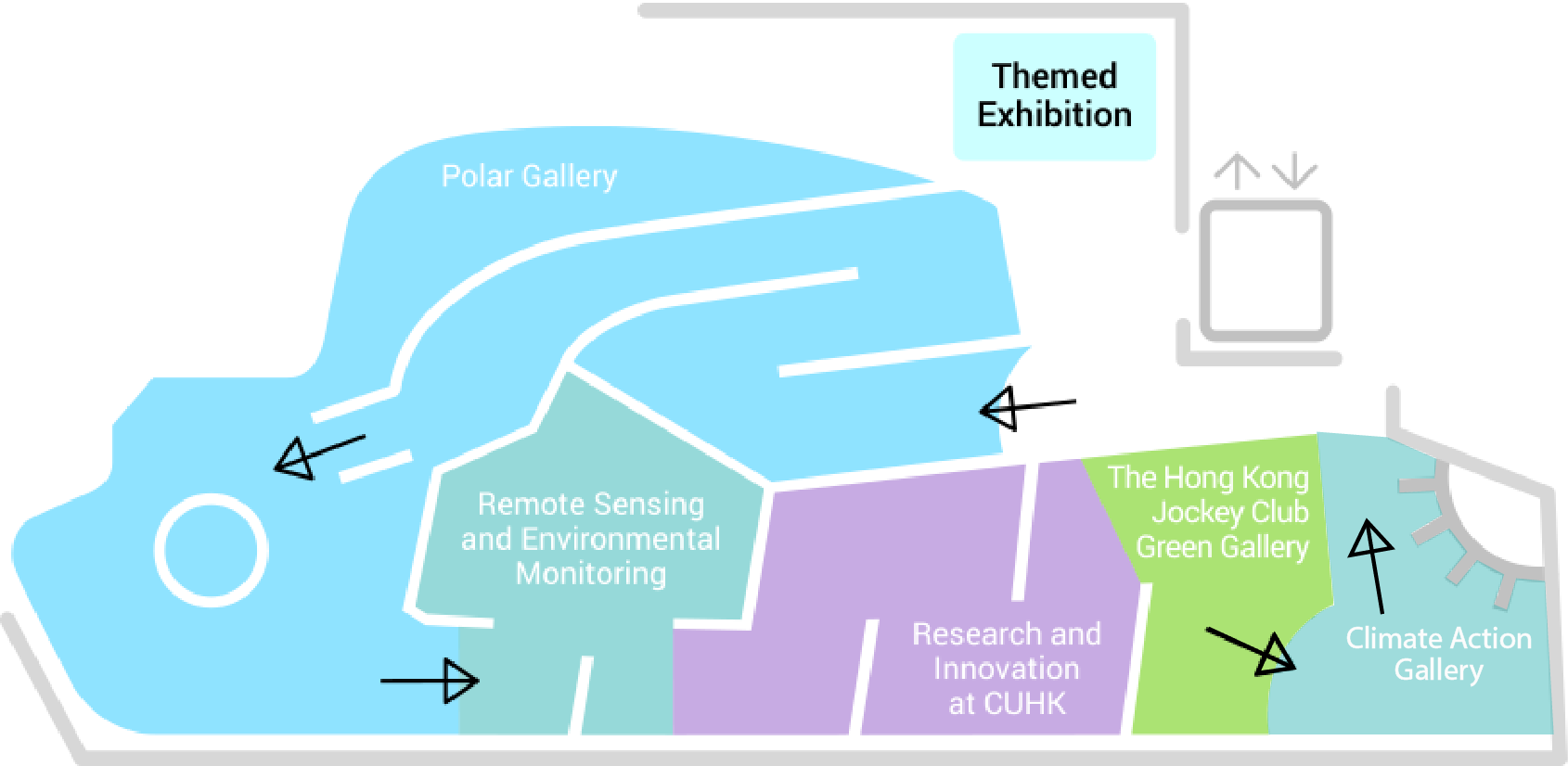
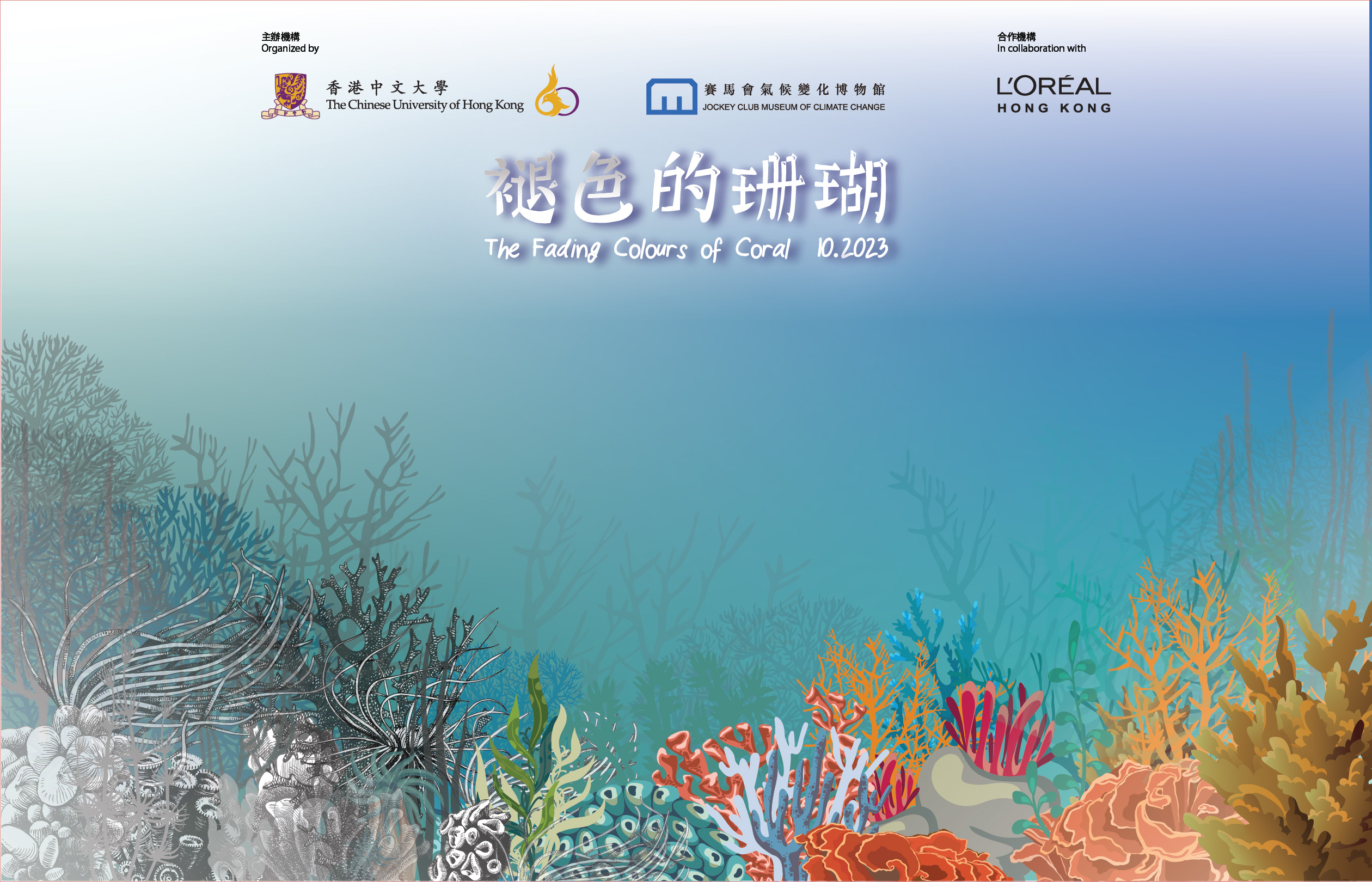
The CUHK Jockey Club Museum of Climate Change (MoCC) will launch the Mobile Exhibition “The Fading Colours of Coral” in October 2023, to showcase potential threats of climate change on marine ecology, with the aim of inspiring students to adopt new thinking and take practical action to address climate change.
Programme Details (Chinese version only)
![]()
The exhibits in this section are based on the valuable collection from Dr Rebecca Lee, the renowned environmentalist and explorer, built through her lifelong fieldwork in the "Three Poles" (the North Pole, the South Pole and Mount Everest) and network with research institutes in mainland China. This collection offers a vivid demonstration to visitors on global warming and climate change, as well as the macroscopic impacts.
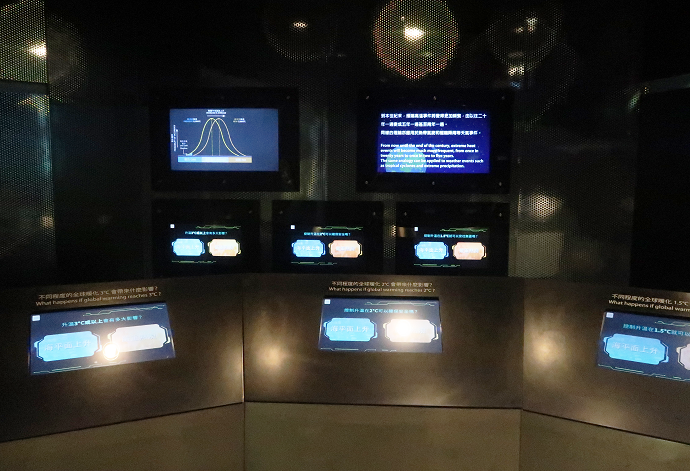
Remote Sensing and Environmental Monitoring is a collection of interactive multimedia presentation of the many types of environmental and climate information derived from Earth-orbiting satellites and other advanced technology. The visitors will be able to explore by themselves, through the application of geo-information science, how the Earth is changing in time and space and how climate change may impact the environment and their daily lives.

![]()
Research and Innovation at CUHK showcases the Chinese University’s innovative research results across a wide spectrum of environmental science and energy technology. Visitors are informed of not only the latest research developments and technological advances, but also the future potentials in these fields to combat climate change.
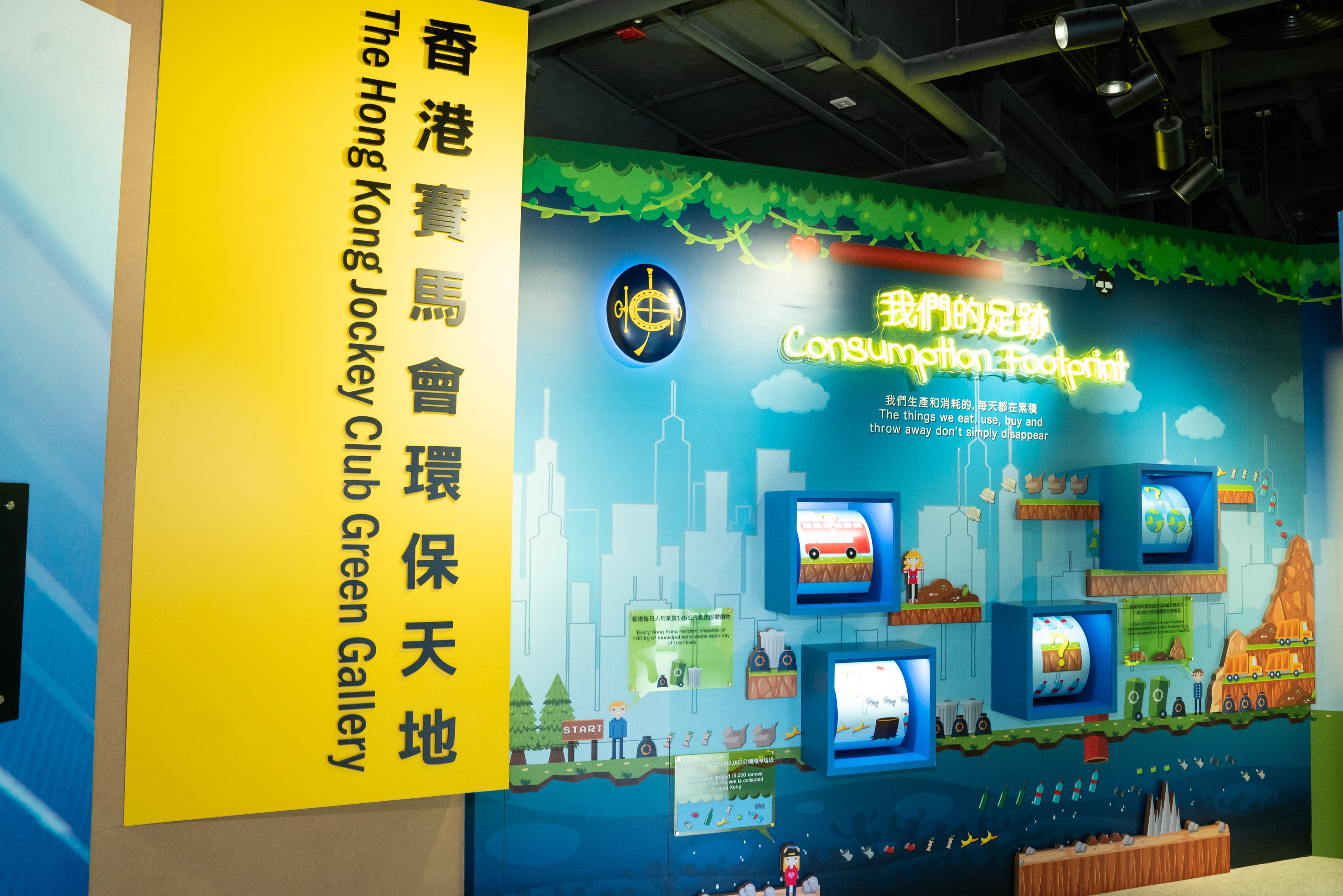
Environmental efforts require the community’s support. The Hong Kong Jockey Club Charities Trust has for years supported a significant number of projects to promote environmental protection in Hong Kong. This section presents major initiatives of the Club that have helped pioneer new thinking on how to protect the environment in the local community. With the aid of multimedia interactive exhibits, the exhibition promotes United Nations’ Sustainable Development Goal (SDG) 12 – Responsible Consumption and Production – and aims to inspire the visitors to get involved in waste-reduction action and to live a green lifestyle.
When you use this mobile application, we will have record of your Domain Name Server address and the contents you have browsed. This information may be used by us for statistical purpose only.
Policy on Personal Data
For the University's policy on personal data, please visit http://www.cuhk.edu.hk/policy/pdo/en/
The Jockey Club Museum of Climate Change of The Chinese University of Hong Kong (hereafter "the MoCC") built the MoCC Mobile App app as a Free app. This SERVICE is provided by the MoCC at no cost and is intended for use as is.
This page is used to inform visitors regarding our policies with the collection, use, and disclosure of Personal Information if anyone decided to use our Service.
If you choose to use our Service, then you agree to the collection and use of information in relation to this policy. The Personal Information that we collect is used for providing and improving the Service. We will not use or share your information with anyone except as described in this Privacy Policy.
The terms used in this Privacy Policy have the same meanings as in our Terms and Conditions, which is accessible at Jockey Club Museum of Climate Change Mobile App unless otherwise defined in this Privacy Policy.
Information Collection and Use
For a better experience, while using our Service, we may require you to provide us with certain personally identifiable information, including but not limited to Email Address, your Domain Name Server address and the pages you have visited. The information that we request will be retained by us and used as described in this privacy policy. For the University's policy on personal data, please click here.
The app does use third party services that may collect information used to identify you.
Link to privacy policy of third party service providers used by the app
Log Data
We want to inform you that whenever you use our Service, in a case of an error in the app we collect data and information (through third party products) on your phone called Log Data. This Log Data may include information such as your device Internet Protocol (“IP”) address, device name, operating system version, the configuration of the app when utilizing our Service, the time and date of your use of the Service, and other statistics.
Cookies
Cookies are files with a small amount of data that are commonly used as anonymous unique identifiers. These are sent to your browser from the websites that you visit and are stored on your device's internal memory.
This Service does not use these “cookies” explicitly. However, the app may use third party code and libraries that use “cookies” to collect information and improve their services. You have the option to either accept or refuse these cookies and know when a cookie is being sent to your device. If you choose to refuse our cookies, you may not be able to use some portions of this Service.
Service Providers
We may employ third-party companies and individuals due to the following reasons:
We want to inform users of this Service that these third parties have access to your Personal Information. The reason is to perform the tasks assigned to them on our behalf. However, they are obligated not to disclose or use the information for any other purpose.
Security
We value your trust in providing us your Personal Information, thus we are striving to use commercially acceptable means of protecting it. But remember that no method of transmission over the internet, or method of electronic storage is 100% secure and reliable, and we cannot guarantee its absolute security.
Links to Other Sites
This Service may contain links to other sites. If you click on a third-party link, you will be directed to that site. Note that these external sites are not operated by us. Therefore, we strongly advise you to review the Privacy Policy of these websites. We have no control over and assume no responsibility for the content, privacy policies, or practices of any third-party sites or services.
Changes to This Privacy Policy
We may update our Privacy Policy from time to time. Thus, you are advised to review this page periodically for any changes. We will notify you of any changes by posting the new Privacy Policy on this page. These changes are effective immediately after they are posted on this page.
Contact Us
If you have any questions or suggestions about our Privacy Policy, do not hesitate to contact us at mocc@cuhk.edu.hk.
收集個人資料聲明
我們會記錄使用本手機應用程式者的域名伺服器地址和曾瀏覽的內容,此等資料僅供統計之用。
個人資料政策
有關本校處理個人資料的政策,請瀏覽http://www.cuhk.edu.hk/policy/pdo/b5/
ECF ‘The Drama of Climate Change and a Low-carbon Future’
Funded by


Supported by the Environment and Conservation Fund (ECF), the two-year ECF ‘The Drama of Climate Change and a Low-carbon Future’ (the ECF project) aimed to educate the public, especially the younger generation, to embrace the importance of making green choices through themed exhibitions, ‘theatre-in-education’, a social media campaign and other experiential learning activities.
The objectives of this ECF project were:
which were achieved by the following five components:
Drama Tour
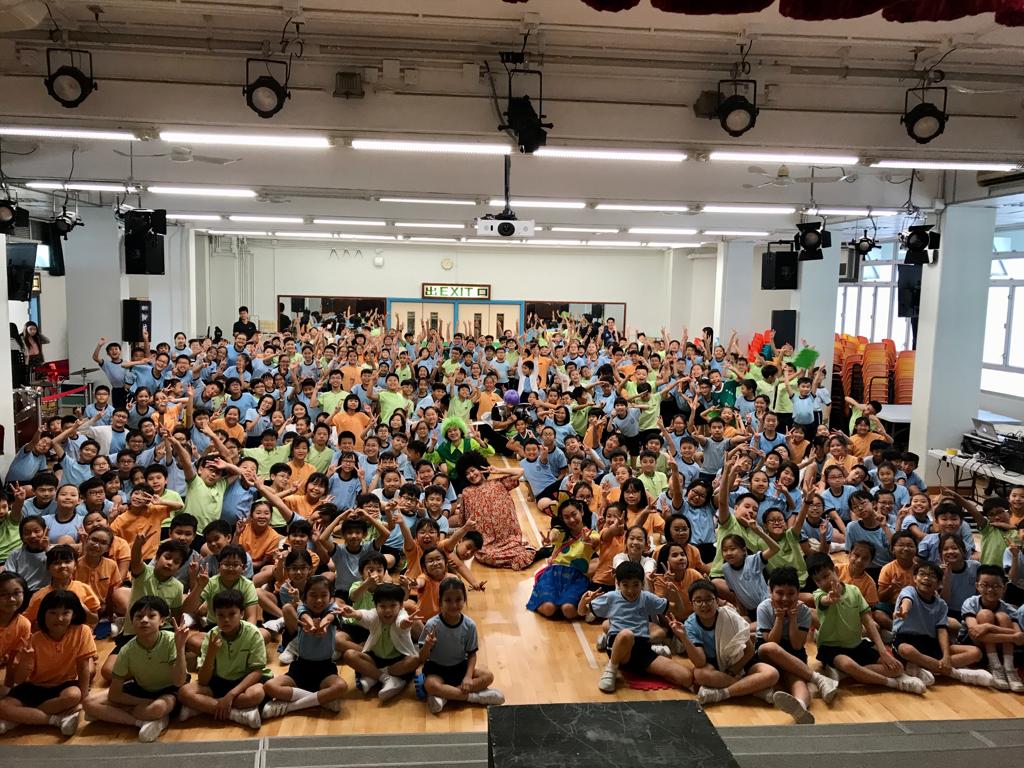 |
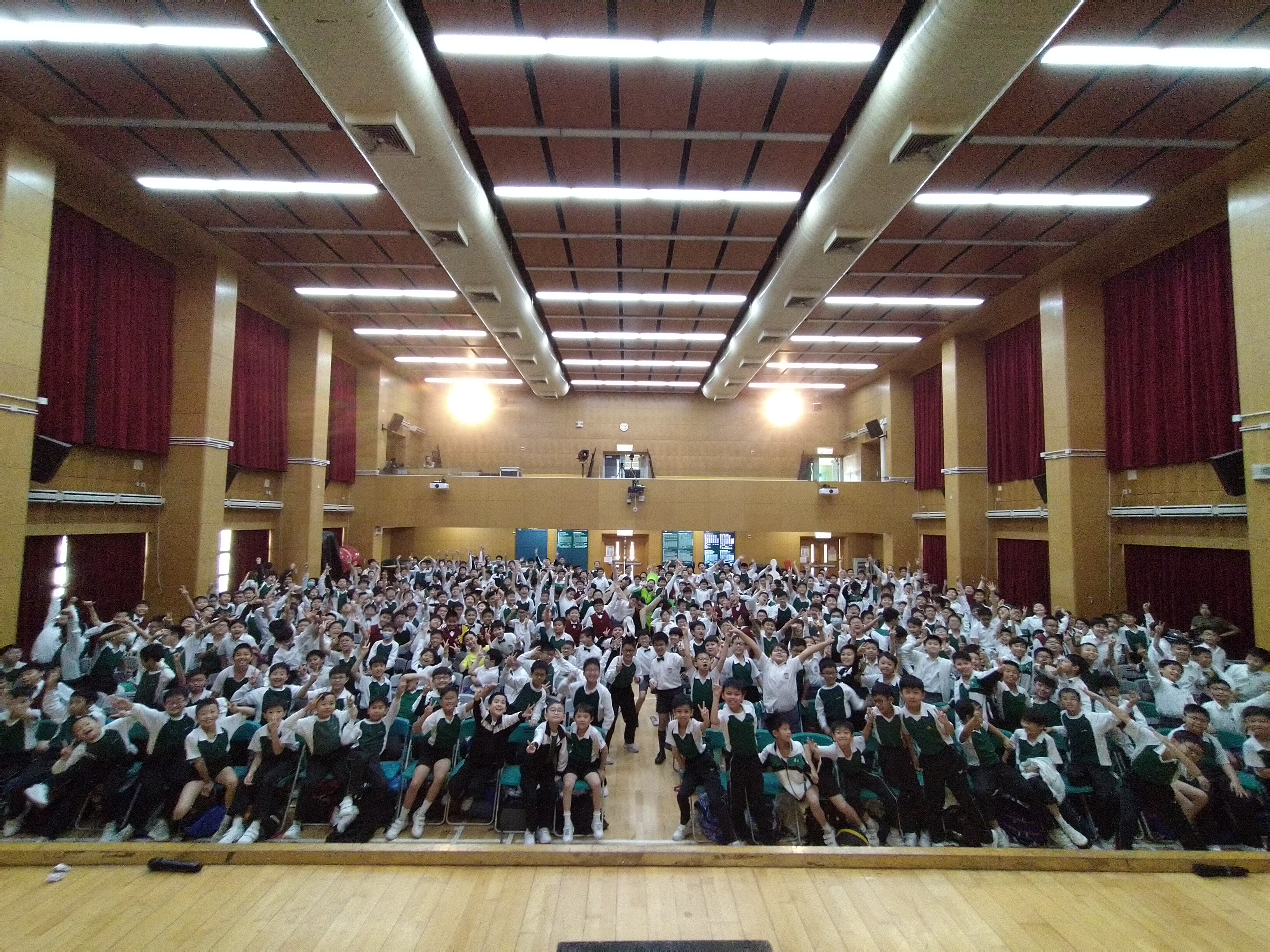 |
An educational drama in the theme of ‘Combating Climate Change: Towards a Low-carbon Future’ was produced by a professional theatre company with input from the scientific team of the Jockey Club Museum of Climate Change. Crafted with actor-audience interactions, the play appealed to young students and inspired them to adopt a more environmentally sustainable lifestyle to combat climate change. Premiered in September 2019, the play has been toured to 34 primary schools as at December 2019, reaching an audience of more than 9,700.
‘The Green Eaters’
The ECF project began with a fun yet, informative ‘The Green Eaters’ social media campaign, followed by the ‘Eating Greener’ exhibition (July to September 2019) at the Jockey Museum of Climate Change, to encourage the general public to increase their intake of plant-based meals, thereby reducing the carbon footprint of the carbon-heavy meat industry. The exhibition attracted close to 10,000 visitors.
Learn and Practise
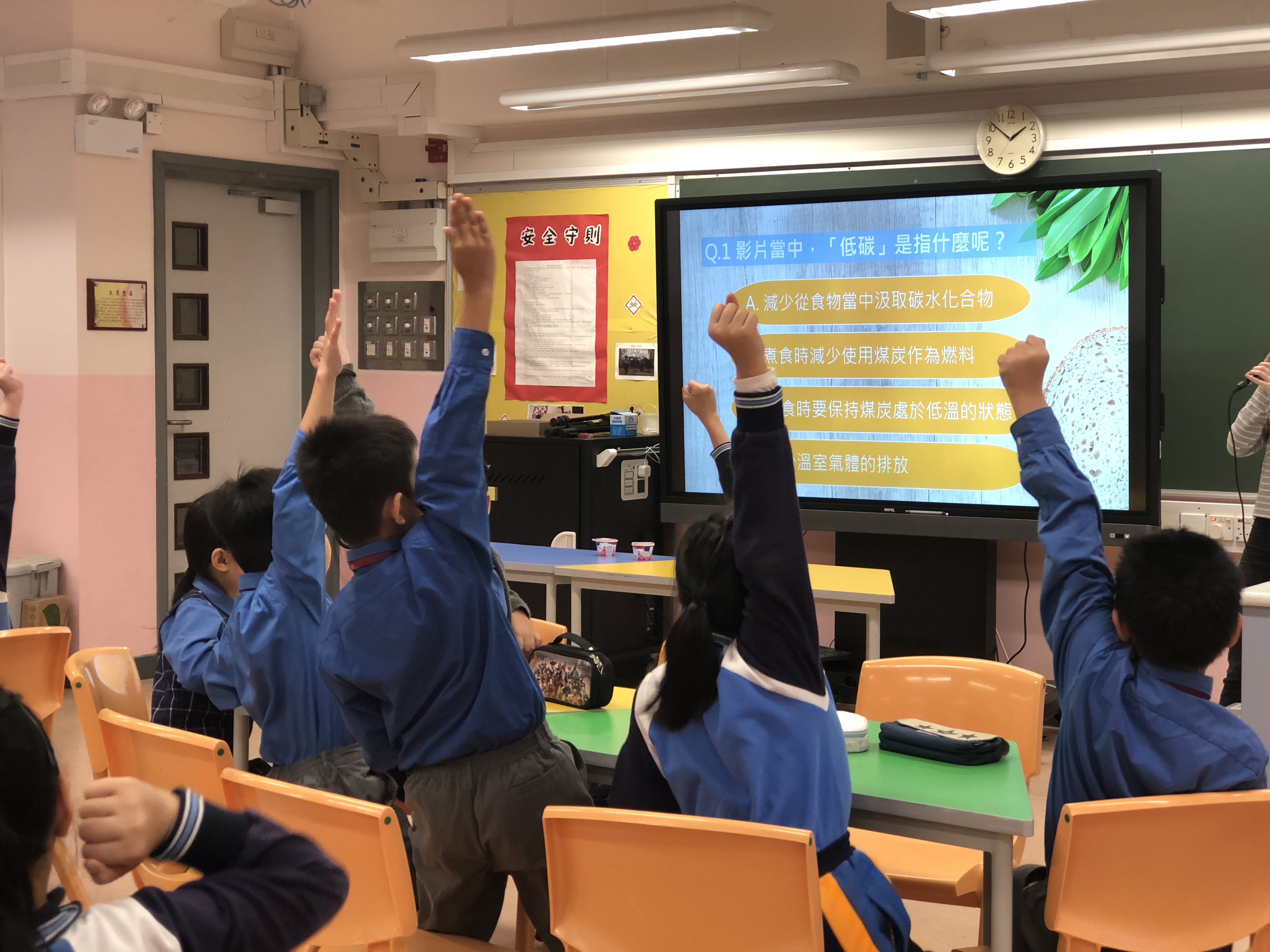 |
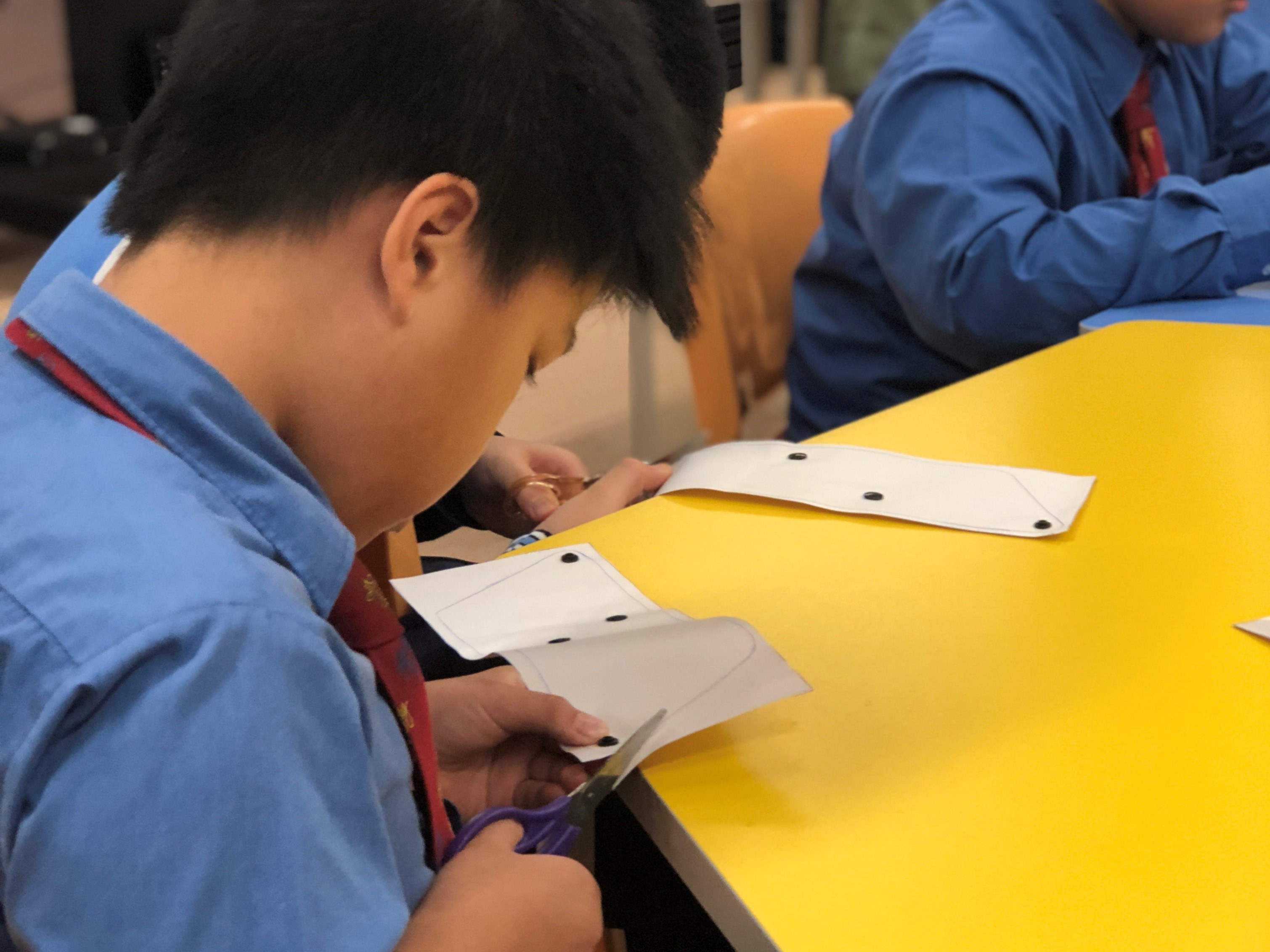 |
To complement and strengthen the primary school students’ knowledge gained from the drama, a series of ‘Learn and Practise’ activities are being carried out for the participating schools. The activities aim to convey a message to the students that they have the ability to change their own behaviour for the good of the planet and also influence their peers and family members to do the same.
GreeXperience@CUHK
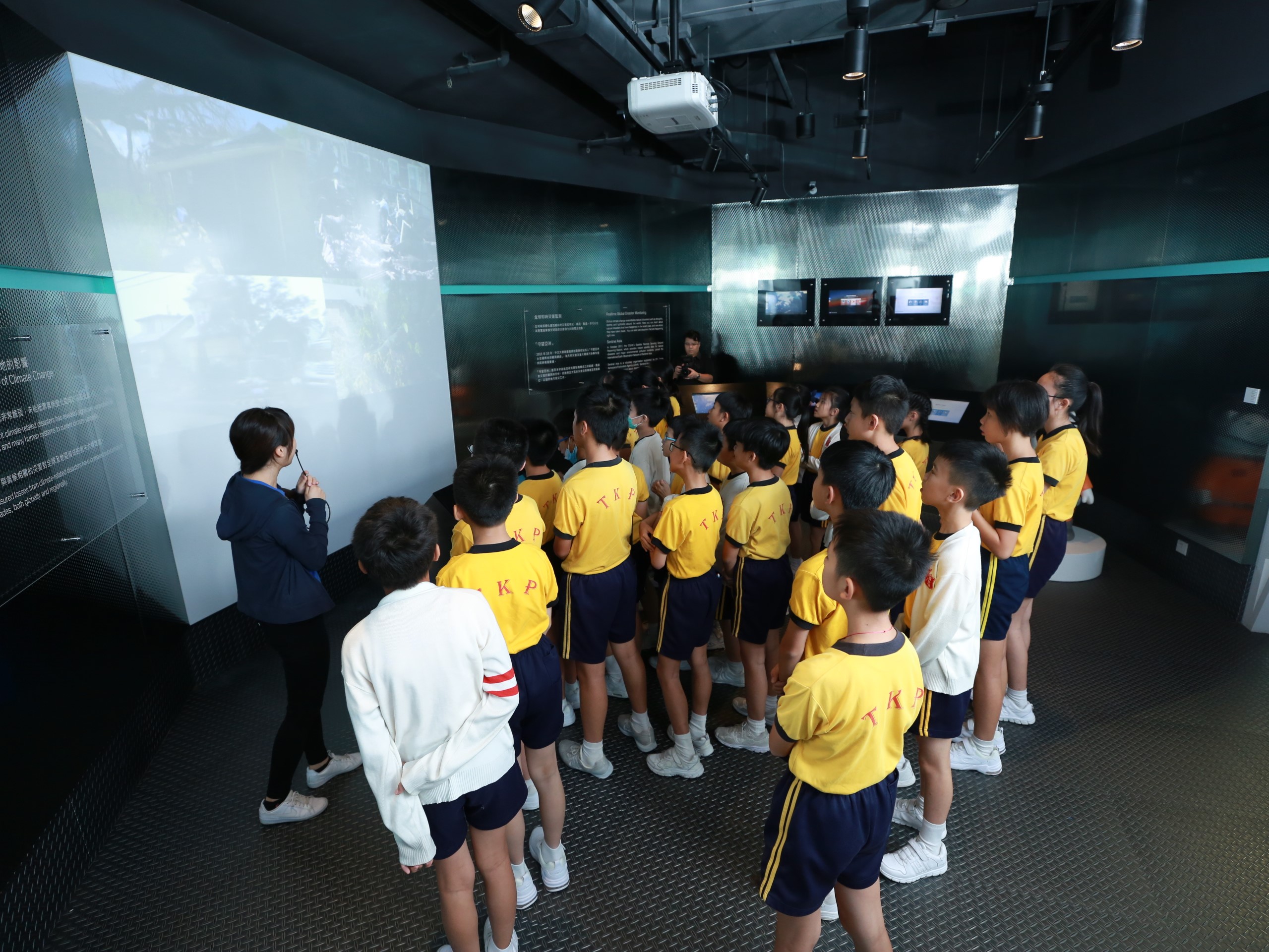 |
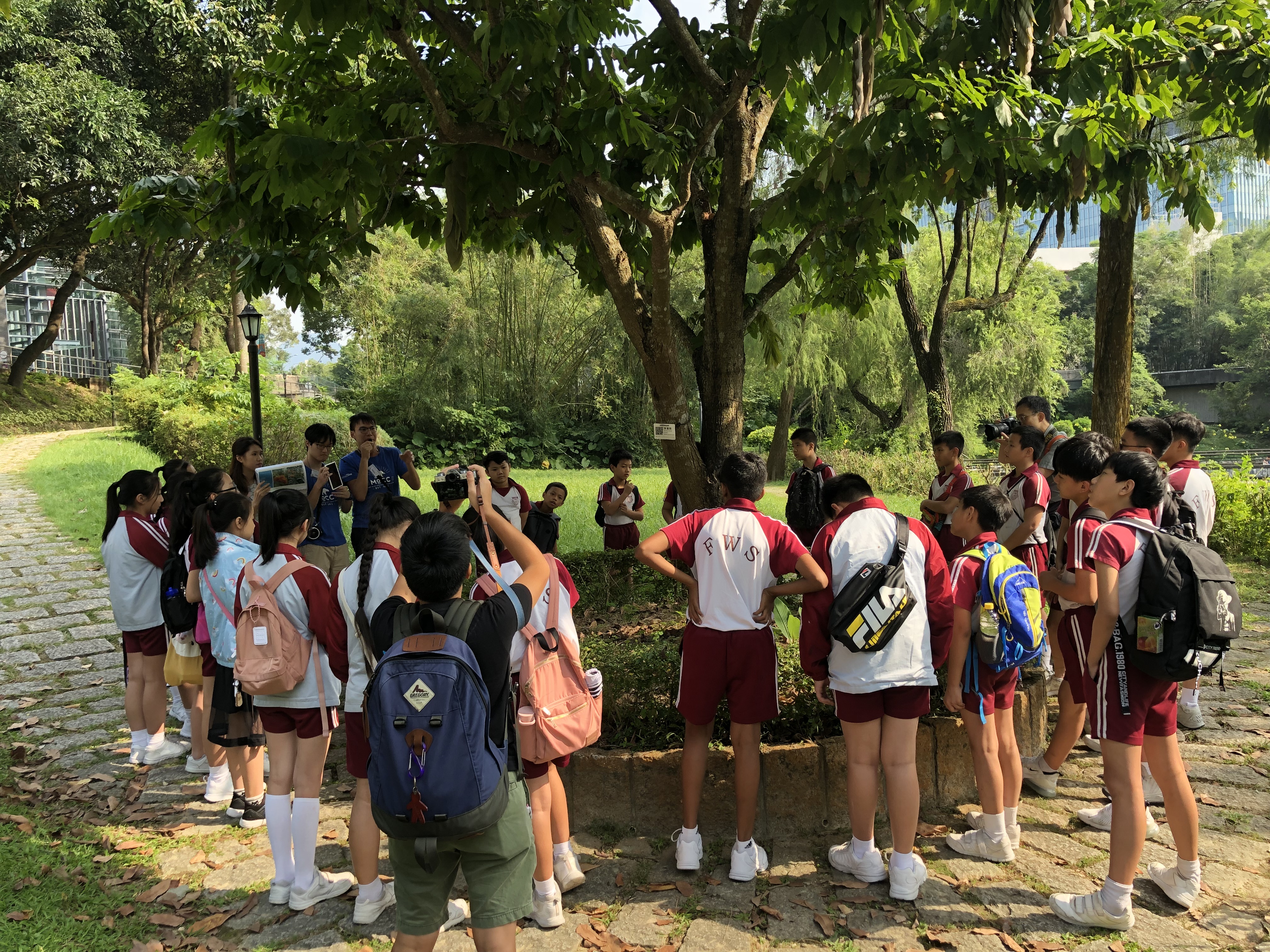 |
To reinforce their understanding of climate change and low-carbon living, the students of the participating primary schools would acquire a special, first-hand green experience, or the ‘GreeXperience’, through environmental activities organized by the Jockey Club Museum of Climate Change. These activities include guided tours of the Museum and guided green tours on The Chinese University of Hong Kong campus.
‘Living Greener’ Virtual Exhibition
‘Living Greener’ virtual exhibition explores the relationship between everyday life and the global climate issues of today. It offers practical things we can do to incorporate sustainability into our daily life.
Enquiries: Richard Chung (3943 3979;richardchung@cuhk.edu.hk)
Disclaimer
Any opinions, findings, conclusions or recommendations expressed in this material/event do not necessarily reflect the views of the Government of the Hong Kong Special Administrative Region, the Environment and Conservation Fund and the Environmental Campaign Committee.
Sustainable Development Goals Gallery
| ‘Sustainable Development Goals in Action’ Exhibition | ‘Small Actions, Big Impact’ Exhibition | |||
ECF Mobilizing Community Climate Action by Future Museum Curators
| Funded by | Supported by | ||||
 |
 |
 |
 |
 |
ECF Mobilizing Community Climate Action by Future Museum Curators is an 18-month school-based community project supported by the Environment and Conservation Fund (ECF). The project capitalizes on the MoCC’s experience in climate outreach and advocacy and represents a unique model of experiential and problem-based learning through curating an exhibition that inspires community pro-climate actions. Student participants (our ‘Future Curators’) will have the opportunity to showcase their works at the MoCC and will reach a larger audience worldwide through our various global partners.
Objectives
Project Components
|
1. |
Training Future Curators |
|
The core component of this project is a comprehensive training programme designed to provide young people with the necessary knowledge and skills to communicate climate change and sustainable development through technology-aided exhibitions. |
|
|
Training Scope
|
|
|
Learning Outcome
|
|
Join us to help your students...
|
|
|
Enhance knowledge of climate change, science communication skills and innovative know-how Through a comprehensive training programme which includes sharing sessions, workshops and field trips, the programme participants (our ‘Future Curators’) will identify problems of climate change and explore the connections between climate change and the United Nations’ (UN) Sustainable Development Goals (SDGs). The training will be provided in multiple modules covering climate change knowledge, basic curation skills and the application of AR technology. |
|
|
Experience the work of a curator The programme will expose the participants to various aspects of a curator’s work, from content research, through description drafting, to exhibit design and development. Under the MoCC’s guidance, the participants will work with their teammates to curate their own exhibitions to be staged at their schools and in a virtual gallery. Selected curating teams will co-curate with the museum team a year-end themed exhibition to be staged at the MoCC. |
|
|
Showcase to the world The participants will have the opportunity to showcase their works to a larger worldwide audience through our global partners. These include:
|
|
|
Target Participants: S1 – S6 students |
|
|
Quota: 6 to 8 students from each school |
|
|
Award:
|
| The programme will consist of a series of interactive class and practical sessions. | |
|
Enrolment (by school)
|
|
|
School seminar
|
|
|
SDG 13 Keepers training (full-day)
|
|
|
InnoCurators museum operation training (full-day)
|
|
|
InnoCurators augmented reality training (full-day)
|
|
|
Future Curators’ exhibitions (brick-and-mortar)
|
|
|
Future Curators’ exhibitions (online)
|
|
|
MoCC exhibition (co-curated with the best-performing Future Curators)
|
|
| * Participating schools should complete the school seminar, the training sessions and Future Curators' exhibitions. |
|
2. |
Climate Action in the Community |
|
Various activities are designed to expand the reach and impact of the project, including:
|
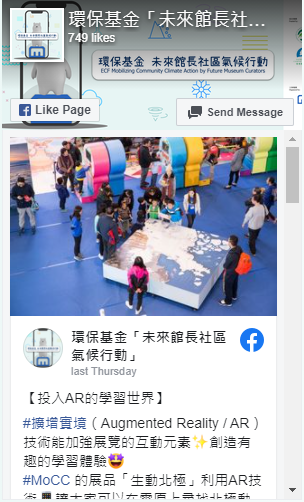 |
 |
|
Visiting green pioneers
|
|
|
A virtual gallery showcasing the exhibitions curated by the Future Curators
|
|
|
A themed exhibition at the MoCC
|
Enrolment
Secondary schools in Hong Kong are invited to submit their applications on or before 24 September 2021.
Applications will be selected on a first-come, first-served basis.
Apply online (In Chinese only)
Enquiries
Jennifer Cheng (3943 0817;jennifercheng@cuhk.edu.hk)
Disclaimer
Any opinions, findings, conclusions or recommendations expressed in this material/event do not necessarily reflect the views of the Government of the Hong Kong Special Administrative Region, the Environment and Conservation Fund and the Environmental Campaign Committee.
Sustainable Development Goals Gallery
| ‘Sustainable Development Goals in Action’ Exhibition | ‘Small Actions, Big Impact’ Exhibition | |||
Test123
Test
| Application Forms | ||
| Jockey Club Museum of Climate Change: Guided Tour Service for Group Visits | online registraion | |
| Friends of the Museum (Individual Membership) Application | online registraion | |
| Friends of the Museum (Institutional Membership) Application | online registraion | |
| Registration for ‘CUHK–JC MoCC Alumni Association’ | online registraion | |
| Application for Hosting ‘Climate Change and Me’ Mobile Museum Exhibition | online registraion | |
Download our worksheet to bring more fun to science learning at the MoCC. The worksheet can be used in the classroom or as part of a pre-booked guided tour to the MoCC.
Download our resources to bring more fun to science learning at the MoCC. These resources can be used in the classroom or as part of a pre-booked guided tour to the MoCC.

Elementary level worksheets (suitable for primary school students)
Advanced level worksheet (suitable for secondary school students)
Please check out the Chinese version
Visitor Information
Exhibition Period: 22 March – 30 June 2018 (closed on Wednesdays, Sundays and public holidays)
Opening hours: 9:30 am – 5:00 pm
Venue: Jockey Club Museum of Climate Change, Yasumoto International Academic Park 8/F, CUHK (Near Exit D, MTR University Station)
Asia
Glaciers in Asia are known to many as the ‘Third Pole’ due to the fact that high mountains of Asia hold the largest frozen water outside the polar areas. They are an invaluable water resource, feeding many of the world’s great rivers, including the Ganges.
This water resource, however, is a risk under the current trend of global warming. Asian mountain glaciers will lose over one third of their mass by the end of this century as a result of global warming, affecting millions of people who rely on them for fresh water, a study finds.

Sabalan Glacier, Iran – Klaus Thymann (2014)
The glacier region of Sabalan rests on an inactive stratovolcano that rises to a height of 4,811 metres in the north-western part of Iran. The highest peaks of the mountains, known as Mount Sabalan, is a crater lake which is covered with ice from September through to June the next year.
Europe
Many of the glaciers in continental Europe develop on mountain ranges: The Alps, the Great Caucasus range, the Scandinavian mountains, Polar Ural and the Pyrenees. Glaciers on Iceland and Svalbard exist on lower altitudes, and exist due to their proximities to the North Pole.
The vast majority of glaciers in Europe are retreating. Those in the Alps have lost half of their volumes since 1900, with clear acceleration since the 1980s. Glacier retreat in Europe is expected to continue in the future.
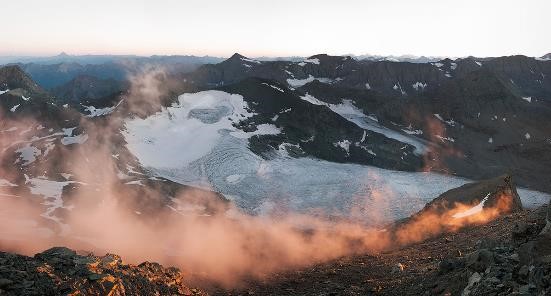
Glacier Du Baoumet, France – Scott Conarroe (2015)
Sunrise shot of Glacier Du Baoumet. In places on the Alps, the borders of Switzerland, Italy, Austria and France are based on watershed. As global warming shrinks the glaciers, so does the watershed shift. The alpine landscapes no longer conform to borders established in the last century.
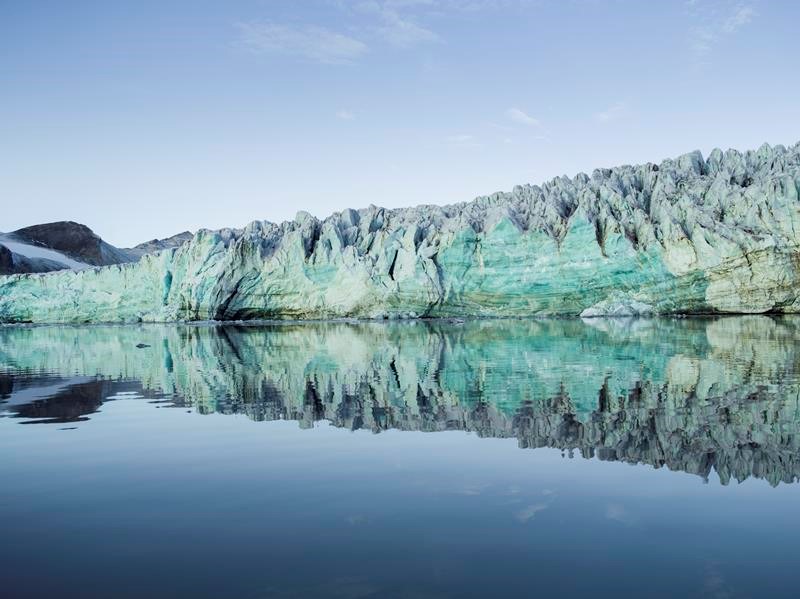
Esmarkbreen, Svalbard – Corey Arnold (2013)
The front of Esmarkbreen, a tidal glacier on the Norwegian archipelago of Svalbard in the Arctic Ocean. The glacier was named Professor Jens Esmark (1763–1839), a Danish-Norwegian pioneer in glacial geology, who was the first to present convincing evidence for a glaciation in northern Europe.
South America
The glaciers in South America develop exclusively on the Andes; many on steep slopes and peaks above elevations of 5,000 metres. One of the most concerned region is the tropical Andes (Venezuela, Colombia, Ecuador, Peru, and Bolivia), where 99% of the world’s tropical glaciers occur. These tropical glaciers are regarded as among the most sensitive indicators of climate change on the planet, according to the Intergovernmental Panel on Climate Change. Being a key aspect of the region’s water cycle, these glaciers have since the 1970s shrunk by 30–50%, an unprecedented rate in the past 300 years.
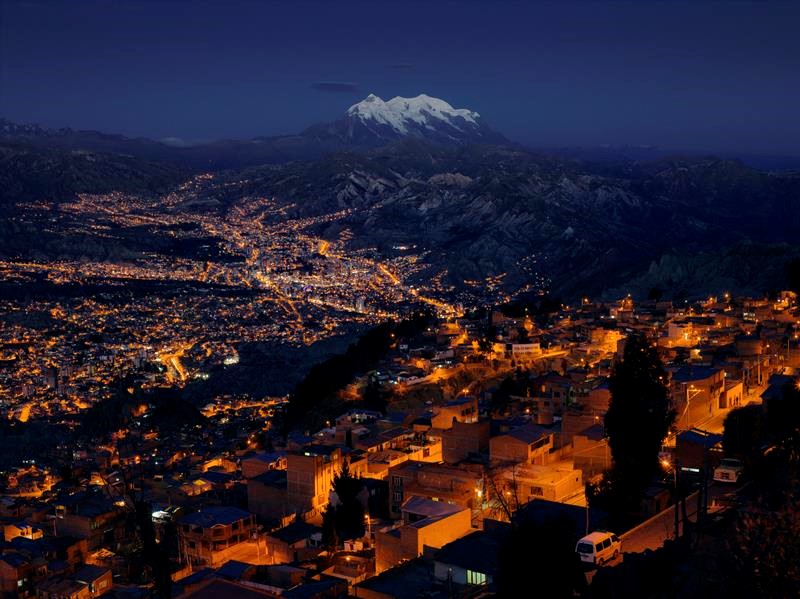
Mount Illimani, Bolivia – Klaus Thymann (2013)
Between the Pacific and the spine of the Andes, which curves through the southwest of the country, lies the vast, arid Andean Plateau. It is home to the city La Paz, and the grasses of the Altiplano Highlands of Bolivia. Further east, the grasslands and dry deserts give way to towering mountains and glaciers, and hidden by the forbidding Andean peaks is the Amazon basin.
Nestled within the Cordillera Real Range is La Paz, the world’s highest capital city at 3,640 metres above sea level. The city with a backdrop of peaks above 5,000 metres, including Mount Illimani, the second highest peak of Bolivia, is sustained by the glacial meltwater runoff. As glaciers recede the landlocked country is losing a vital resource that is not only used for water consumption but also contributes to forestry and agriculture, indigenous communities’ livelihood, and hydroelectric power generation.
North America
Glaciers in North America exist in both the United States and Canada, as well as in Greenland. Many of these glaciers are well monitored and designated as protected areas of National Parks in the United States and Canada. Albeit protected, many of these areas, if not all, are still affected by climate change. One of such areas are Mount Baker-Snoqualmie National Forest in the United States.
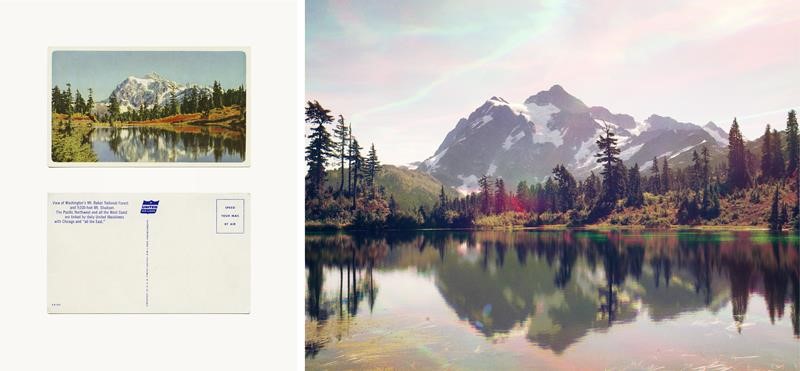
Mount Baker, USA – Peter Funch (2014)
Mount Baker, located in Washington State, USA, is a unique place where the effects of climate change can be seen from the accumulation of over a century’s worth of photographic documentation in tourist memorabilia. Following in the footsteps of Ansel Adams, Funch’s replica images of the existing collection of postcards and archival photography provide a decisive juxtaposition that highlights how the landscape has changed over time.
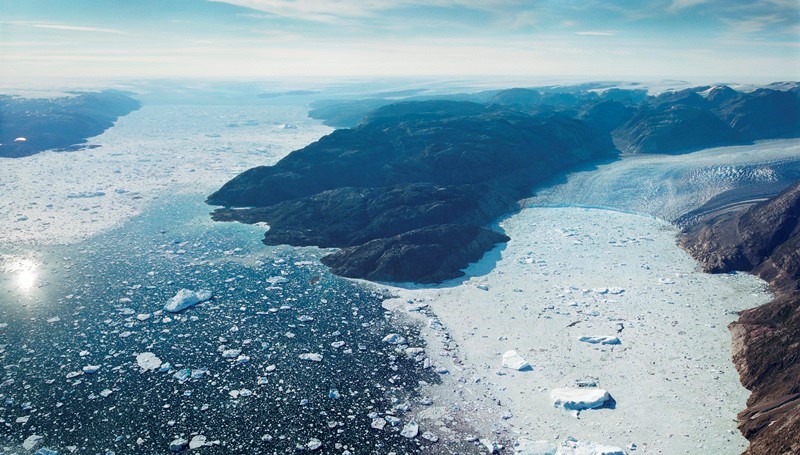
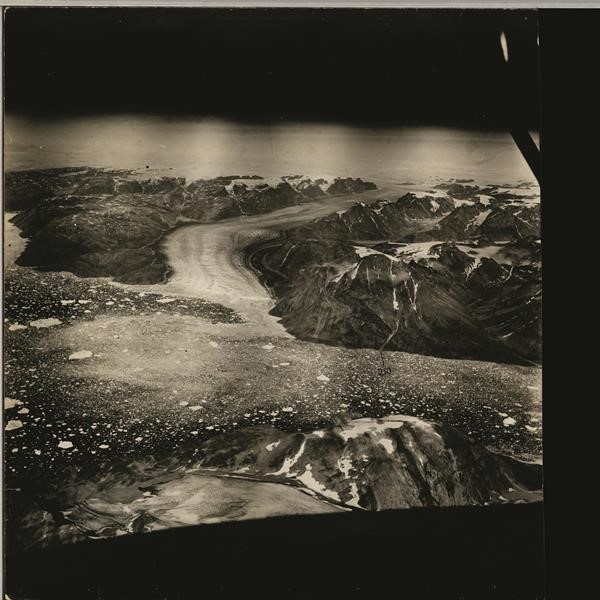
Helheim and Fenris Glaciers, Greenland – Klaus Thymann (2012) and Keld Milthers (1933)
In the early 20th Century, Denmark was in dispute with Norway over the sovereignty of eastern Greenland. To substantiate its claim, Denmark set forth expeditions to survey the remote region, including an aerial photograph survey by Danish explorer Keld Milthers in 1933. The aerial photographs, which were eventually rediscovered by Kurt Kjær of the Natural History Museum of Denmark in 2009, clearly outlined Greenland’s coasts, as well as the continent’s glaciers.
Collaborating with Kjær and the archive, Klaus Thymann revisited Helheim and Fenris Glaciers in East Greenland in 2012 to replicate the aerial photographs. The new photographs were taken same time of year as did Keld Milthers so that the historic and modern photographs can be compared directly. They demonstrate how the glaciers have retreated over 70 years.
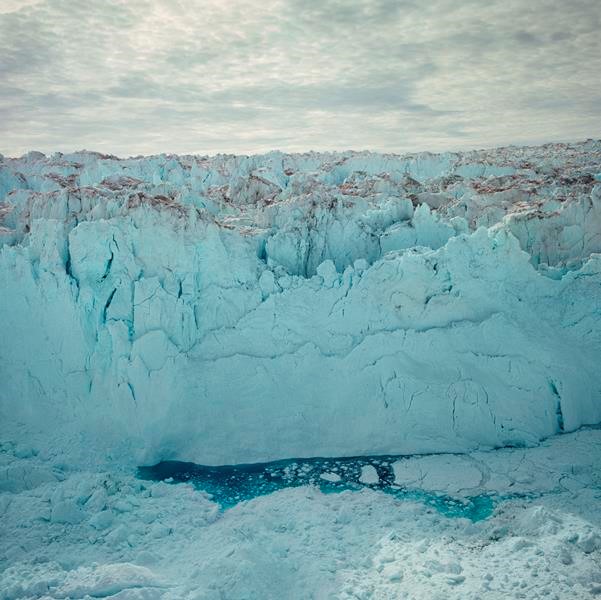
Jakobshavn Glacier, Greenland – Klaus Thymann (2009)
Shot out of an open door on a hovering helicopter, the image shows the front of the Jakobshavn Glacier in Greenland. The wall is about 70 metres high. This glacier is among, if not the most, active in the world, producing some 10% of all of Greenland’s icebergs. The glacier moves forward at an average pace of 20 metres per day.
Africa
Resembling those in South America, glaciers in Africa are altitude related. Occurring in high mountains and close to the equator, they are very sensitive to temperature changes and therefore to global warming. Some believe that Africa is likely to be the first continent to be glacier-free due to climate change.
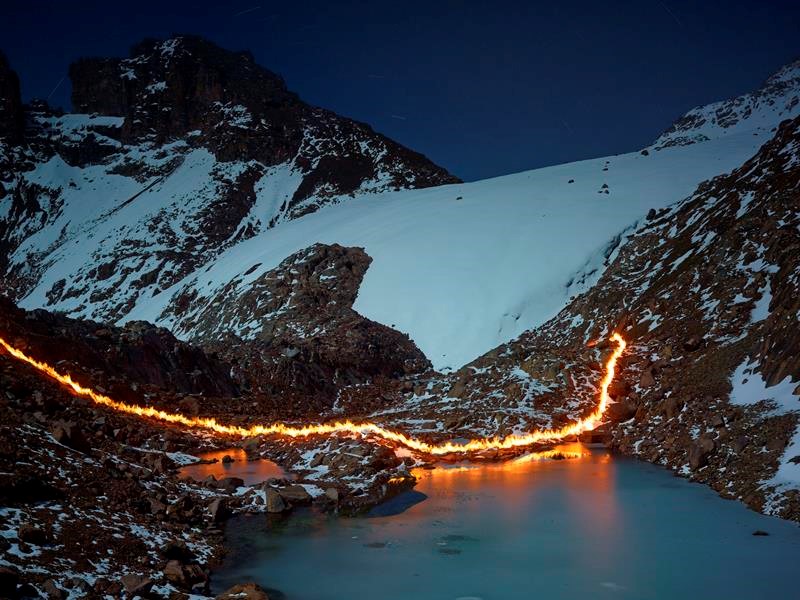
Lewis Glacier, Kenya – Simon Norfolk (2014)
Mount Kenya used to host many glaciers, this is no longer so. As a visual way of showing glacier retreat, Simon Norfolk used a self-made fire torch and a long exposure to demarcate the line to which a glacier once extended.
Mount Kenya is an extinct 5,199-metre volcano and this series intends to photographically re-awaken the mountain’s magma heart. The ‘Fire versus Ice’ metaphor is poignant owing to the trail of light being made from petroleum; the only evidence in these images that this glacier’s retreat is believed to be due to man-made climate change.
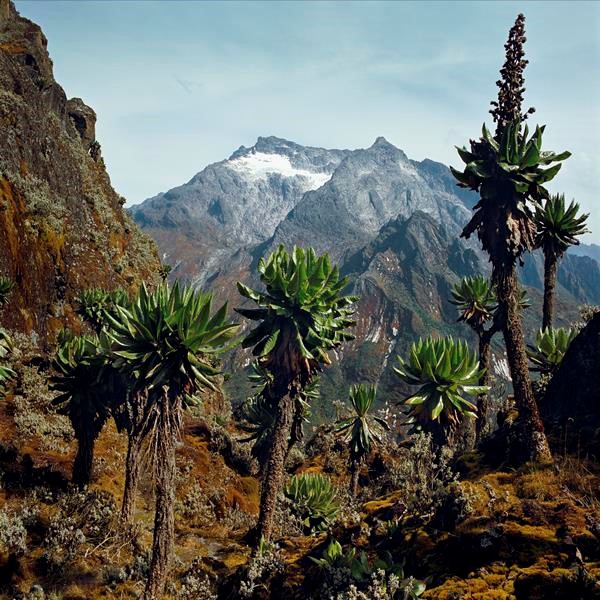
Speke Glacier, Uganda – Klaus Thymann (2012)
On the border of Uganda and the Democratic Republic of Congo, are the Rwenzori Mountains. This UNESCO-listed national park is home to six peaks above 4,600 metres, as the highest source of the Nile, they are also known as ‘The Mountains of the Moon’. Barely explored until the turn of the 20th Century it is estimated the glaciers will completely disappear within the next 15 years.
In 1906, there were 43 glaciers in the region; now only half remain and with a total coverage area of less than one square kilometre. The mountains are also home to 177 species of bird and mammals and an abundance of unusual flora. The tropical rains, high altitude and untouched landscape create conditions that encourages unique species to thrive. Thymann used a route that had lain unused for decades, after Congolese insurgents closed the park; through this route he discovered glaciers that were thought disappeared.
Australasia
No glacier exists in Australia. By contrast, there are as many as 3,000 glaciers in New Zealand. Many of them are located in the Southern Alps on the South Island and classified as mid-latitude mountain glaciers. They have been retreating since 1890.
When the glaciers retreat, some form proglacial lakes such the one shown in front of Donne Glacier, Mount Tutoko, New Zealand. Satellite imagery has revealed that many proglacial lakes in New Zealand are expanding in size due to glacier retreat.
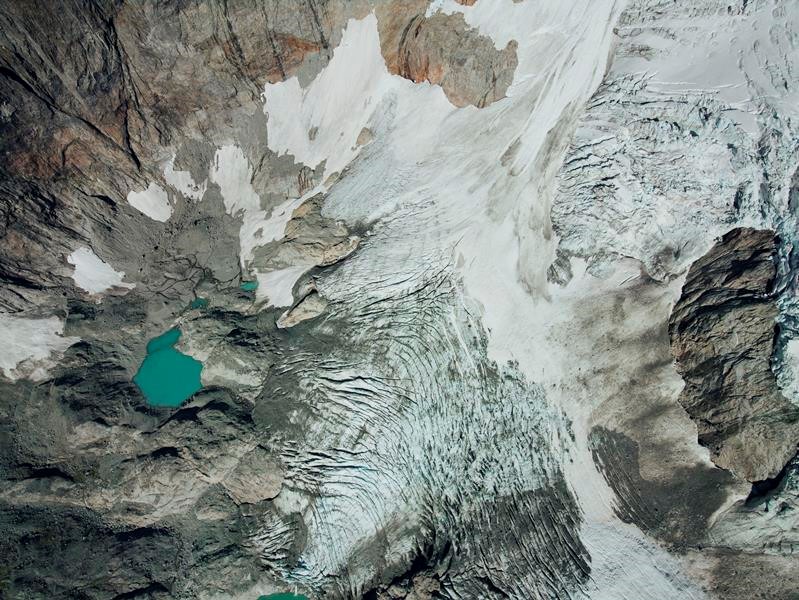
Donne Glacier, New Zealand – Klaus Thymann (2013)
Top view of Donne Glacier, which descends down on the east face of Mount Tutoka, southwest New Zealand. This glacier has been undergoing rapid retreat for decades and in 2000 a new unnamed alpine lake was formed.
Antarctica

Pine Island Glacier and Antarctic Peninsula, western Antarctica – Satellite Image (2016)
This image shows the Antarctic Peninsula in western Antarctica, with the Pine Island Glacier in the lower left.
The Pine Island Glacier, one the largest glaciers in western Antarctica, is the fastest thinning glacier in Antarctica, responsible for some 25% of Antarctica’s ice loss. It loses an extraordinary 45 billion tonnes of ice to the ocean each year — equivalent to 1 millimetre of global sea level rise every eight years. The ice loss rate is alarmingly accelerating. The single glacier contains about 52 centimetres of potential global sea level rise and is thought to be in the process of unstable retreat.
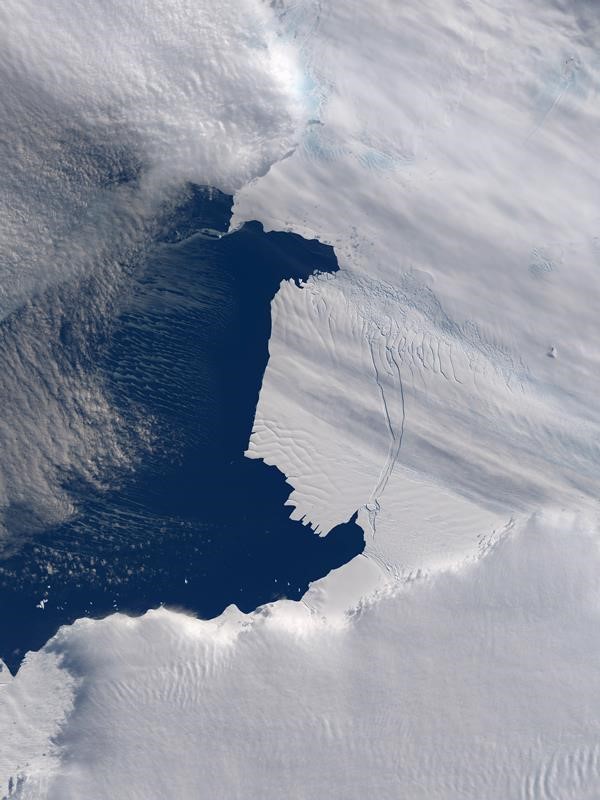
Larsen C, western Antarctica – Satellite Image (2013)
In July 2017, a giant iceberg, known as A68 and measuring 5,800 square kilometres in size, broke free from Larsen C ice field in western Antarctica. (For comparison, Hong Kong Island is 80.5 square kilometres in size) It is one of the largest icebergs ever recorded. This image is a retrospect of how Larsen C looked like in 2013 — a large rift had already been developed (centre of image).
A collection of multimedia-enhanced and interactive modules to educate users on the impact of climate change memorably and enjoyably. The second collection in the series, ‘Climate Change and Me’, consists of seven modules. They reveal how human activities and climate change are closely interlinked and promote important green concepts such as clean energy, a low-carbon lifestyle and sustainable development. Schools or organizations interested in hosting the exhibition may click here for further details.

Consulate General of France in Hong Kong & Macau
December 2016
| (852) 3943 9632 | ||
| mocc@cuhk.edu.hk | ||
| Yasumoto International Academic Park 8/F The Chinese University of Hong Kong Shatin, NT, Hong Kong |
||
The MoCC Ambassadorship recognizes and provides financial support for outstanding CUHK students who wish to intern in the MoCC to raise climate change awareness and promote sustainability on and beyond campus. MoCC Ambassadors undergo knowledge training in climate change, sustainability and museum operations.
Each MoCC Ambassador is required to pursue, under supervision, experiential learning that carries educational benefits for the Ambassador and are relevant to the MoCC’s operational and outreach activities.
Details of the requirements and financial support of the MoCC Ambassadorship are outlined in the programme flyer. When the students graduate from the ambassadorship, each of them will be awarded a certificate of completion. The ambassadorship may be renewed for another academic year upon demonstration of excellent performance and the availability of funding.
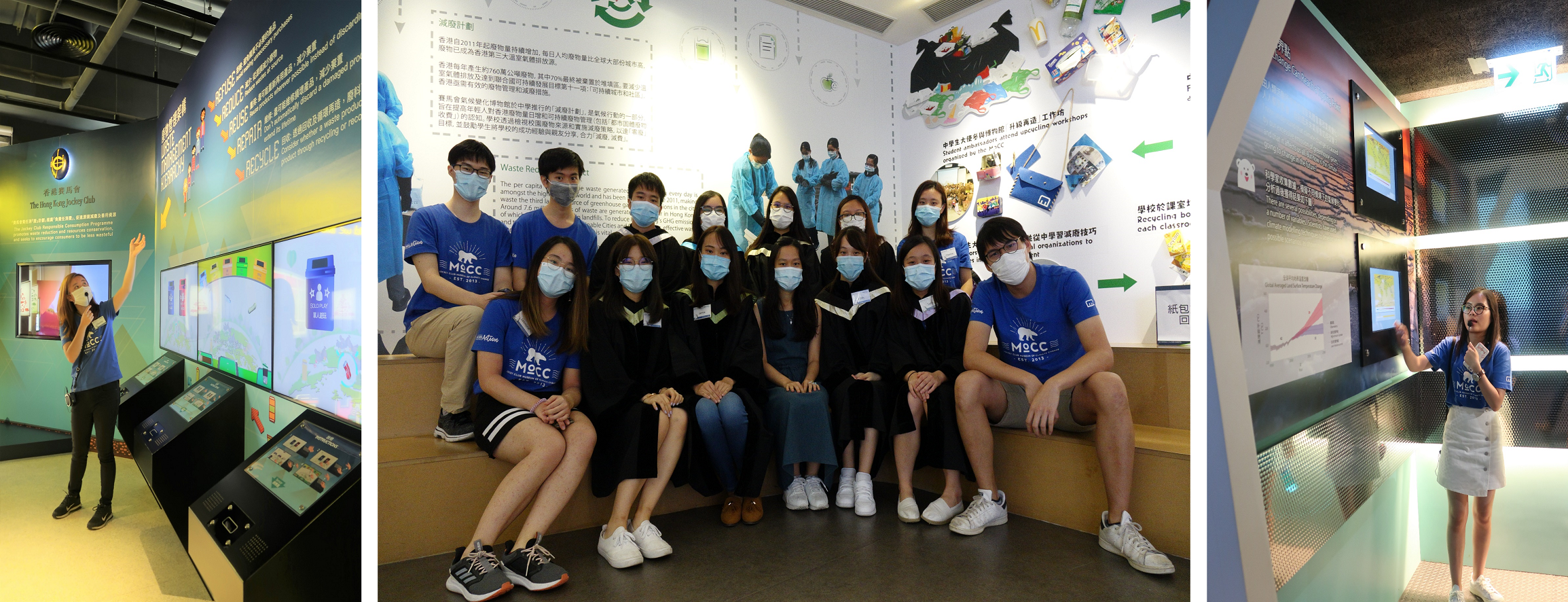
Applications are open to all undergraduate and postgraduate students of CUHK. Students in related fields (major or minor), such as sustainable development, earth system science, museum studies, geography, energy and environmental engineering, environmental science, anthropology or those who have a track record in participating in environmental services, may be given priority.
Interested students are requested to complete the online application form by 11:59 pm, 7 January 2021.
Shortlisted applicants will be invited to attend a selection interview to be held on 14 or 15 January 2021.
The MoCC Ambassadors are required to:
Deadline for Application
7 January 2021 (Thursday)
Selection Interview
14 or 15 January 2021 (Thursday or Friday)
Knowledge Training (Tentative)
Online sessions (1:30pm–6:00pm)
Onsite session (TBC)
Dry run of tour, 4 hours
Monthly Meetings
First Friday afternoon of each month:
Questions are welcome and should be directed to Ms Samantha Chui on 3943 3012 or by email at samanthachui@cuhk.edu.hk.
A well-curated resources hub packed with information on environmental protection, climate change and sustainable development, and designed to inspire the public to take action to combat climate change.
